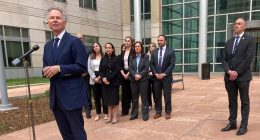
Hundreds of thousands of students are missing out on free college aid because they are not completing a pesky federal form known as the Fafsa, a new analysis finds.
Roughly 1.7 million high school graduates didn’t file the Free Application for Federal Student Aid in the 2020-21 school year. And just under half of them — about 813,000 students — were eligible for federal Pell Grants aimed at low-income students, according to a report by the National College Attainment Network, a nonprofit group that works on behalf of low-income and minority students. The average grant, which doesn’t need to be repaid, would have been almost $4,500.
All told, the high school class of 2021 left an estimated $3.7 billion in available Pell Grants unclaimed by failing to file the form, the network found. It said the number of students filing the Fafsa had dropped during the pandemic.
The Fafsa is the portal to most types of financial aid for college students and must be filed annually. The federal government uses the form to determine whether students qualify for financial aid, including Pell Grants. (Many states and colleges award their own aid based on the Fafsa as well.) Schools with high concentrations of low-income students and students of color consistently have lower Fafsa completion rates, the network said.
Students who complete the Fafsa are much more likely to attend college than those who don’t, so it’s frustrating that the number of students filing the Fafsa has fallen, said Kim Cook, the network’s chief executive.
When districts switched to virtual classes in the 2020-21 school year to avoid spreading Covid-19, many schools weren’t able to hold traditional help sessions to guide students and families in completing the form. Just over half (53 percent) of students in the class of 2021 completed a Fafsa by the summer, down from about 56 percent in 2020, the network estimated. Schools with concentrations of low-income students and students of color saw greater declines.
“The class of 2021 was disconnected from support,” Ms. Cook said. “Some students don’t even know there is federal student aid available.”
Other research has raised concern about the Fafsa as well. A survey last year by EAB, an education consulting firm, found low-income and first-generation students were far more likely to report difficulty filling out the form, and in getting help gathering tax documents and other necessary information. Students often don’t fill out the form because they think they won’t qualify for aid, said Brett Schraeder, managing director of financial aid optimization at EAB.
The federal government recently approved legislation to reduce the number of questions on the Fafsa and otherwise simplify the form, but the changes aren’t scheduled to take full effect until the 2024-25 school year.
Some states, including Louisiana, have made filing the Fafsa a graduation requirement for high school students to help lift completion rates
Ms. Cook’s network is encouraging school districts to use some of the funds they receive from the federal pandemic relief program to expand support for post-high school preparation, including Fafsa completion assistance.
Here are some questions and answers about the Fafsa and student aid:
How much aid could I get from a Pell grant?
The maximum grant is set by Congress and is currently $6,495. Not all eligible students get the full amount; that depends on financial details reported in the Fafsa and other factors, like the cost of the school they are attending. Legislation pending in Congress would double the maximum amount and expand eligibility for the grants, but its outcome is uncertain.
Where can I get help completing the Fafsa?
Most schools are back to in-person learning, and counselors should be more available, although many have heavy workloads, Ms. Cook said. “Reach out and ask a counselor,” she said.
The Coronavirus Pandemic: Key Things to Know
Some schools are working with community groups to bolster college preparation for students. OneGoal, a nonprofit group with programs in Illinois and several other states, works with schools to help them expand in-school instruction for students on post-high school planning. Classes, taught by school staff with support from OneGoal coaches, typically include help with Fafsa preparation.
Mr. Schraeder with EAB said the federal Student Aid Office has helpful information on its website, including a YouTube channel with videos that walk you through the process.
When should I file the Fafsa?
Each year, a new Fafsa becomes available on Oct. 1 for the following academic year, and may be filed until June 30 after the applicable school year ends. (The form for the 2022-23 school year, for instance, opened on Oct. 1, 2021, and can be filed until June 30, 2023.)
It’s always best to file the form as soon as possible after it becomes available. Some states set earlier priority deadlines for allotting their own aid and scholarships to students, so filing early increases your chances of maximizing aid.
But when it comes to Pell Grants, Mr. Schraeder said, students can file at any time. Students often assume that if they missed a state’s priority deadline, it’s not worth the bother. But that’s not the case with Pell Grants, if you qualify. You can file the Fafsa for the current academic year until the end of June. If you haven’t filed for the current school year, he said, you may be depriving yourself of cash assistance. “It’s still not too late for this year,” he said.
It’s possible that even after the priority deadlines, there may be some state or institutional aid left, he said, so it’s worth applying. The worst case is that the school may tell you no funds are available. But, he said, that also “lets the student know that the following year they might qualify if they act more quickly.”
Source: | This article originally belongs to Nytimes.com








